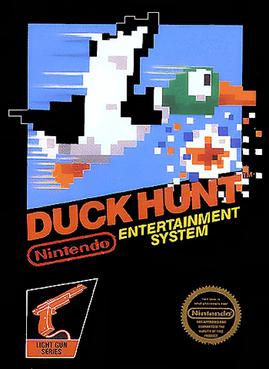
Duck Hunt is a 1984 light gun shooter video game developed and published by Nintendo for the Nintendo Entertainment System (NES). The game was first released in April 1984 in Japan for the Family Computer (Famicom) console and in North America as an arcade game for the Nintendo VS. System. It became a launch game for the NES in North America in October 1985, and was re-released in Europe two years later.
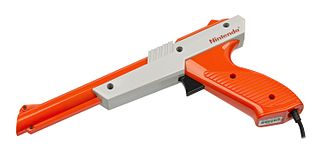
A light gun is a pointing device for computers and a control device for arcade and video games, typically shaped to resemble a pistol.
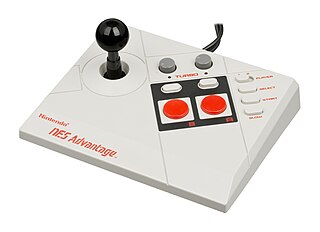
The NES Advantage is an arcade style controller manufactured by Asciiware and released by Nintendo for the Nintendo Entertainment System in 1987. The device is meant to rest on a flat surface at a comfortable level, such as a tabletop or the floor, with the player seated behind it. This way, it can be used like an arcade game joystick—with the left hand using the joystick and the right hand operating the buttons.

The Zapper is an electronic light gun accessory launched within the Nintendo Entertainment System (NES) in North America on October 18, 1985. It is a cosmetic redesign by Nintendo of America's head designer Lance Barr, based on Gunpei Yokoi's Video Shooting Series light gun (光線銃シリーズガン), which had been released in Japan for the Famicom on February 18, 1984. The Zapper requires compatible NES games, such as Duck Hunt, Wild Gunman, and Hogan's Alley. Its internal optical sensor allows the player to aim at a television set and accurately shoot at in-game targets.

Contra is a 1987 run and gun video game developed and published by Konami for arcades. A home version was released for the Nintendo Entertainment System in 1988, along with ports for various home computer formats, including the MSX2. The arcade and computer versions were localized as Gryzor in Europe, and the NES version as Probotector in the PAL region.
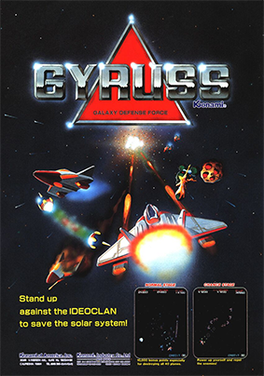
Gyruss is shoot 'em up arcade video game designed by Yoshiki Okamoto and released by Konami in 1983. Gyruss was initially licensed to Centuri in the United States for dedicated machines, before Konami released their own self-distributed conversion kits for the game. Parker Brothers released contemporary ports for home systems. An enhanced version for the Family Computer Disk System was released in 1988, which was released to the North American Nintendo Entertainment System in early 1989.
Exidy, Inc. was an American developer and manufacturer of coin-operated electro-mechanical and video games which operated from 1973 to 1999. They manufactured many notable titles including Death Race (1976), Circus (1978), Star Fire (1978), Venture (1981), Mouse Trap (1981), Crossbow (1983), and Chiller (1986). They were also the creators of the Exidy Sorcerer (1978) home computer platform.

Xevious is a vertically scrolling shooter arcade video game developed and published by Namco in 1982. It was released in Japan by Namco and in North America by Atari, Inc. Controlling the Solvalou starship, the player attacks Xevious forces before they destroy all of mankind. The Solvalou has two weapons at its disposal: a zapper to destroy flying craft, and a blaster to bomb ground installations and enemies. It runs on the Namco Galaga arcade system.

Hogan's Alley is a light gun shooter video game developed and published by Nintendo. It was released for the Family Computer in 1984 and then the arcade Nintendo VS. System and Nintendo Entertainment System in 1985. It was one of the first hit video games to use a light gun as an input device, along with Nintendo's Duck Hunt (1984). The game presents players with "cardboard cut-outs" of gangsters and innocent civilians. The player must shoot the gangs and spare the innocent people. It was a major arcade hit in the United States and Europe.

Gumshoe is a light gun shooter video game developed and published by Nintendo for the VS. System arcade hardware and the Nintendo Entertainment System console. It was released in 1986 in North America and in 1988 in Europe. Unusual for a Nintendo game, it was not released in Japan. It was designed by Yoshio Sakamoto.

Wild Gunman is a light gun shooter game developed and published by Nintendo. Originally created as an electro-mechanical arcade game in 1974 by Gunpei Yokoi, it was adapted to a video game format for the Famicom console in 1984. It was released in 1985 as a launch game for the Nintendo Entertainment System (NES) with the Zapper light gun.

Crossbow is a light gun shooter released as an arcade video game by Exidy in 1983. It was later published by Absolute Entertainment for the Commodore 64 and MS-DOS, and by Atari Corporation for the Atari 2600, Atari 7800, and Atari 8-bit computers starting in 1987. The game is controlled via a positional gun that resembles a full-sized crossbow.

To the Earth is a light gun shooter video game developed by Cirque Verte and published by Nintendo for the Nintendo Entertainment System. It was released in November 1989 in North America and in Europe on February 23, 1990. It uses the NES Zapper to destroy ships and gain power-ups. The enemy spacecraft require good reflexes and aiming.

Double Dribble is an arcade basketball video game developed and released by Konami in 1986. It was the second basketball arcade video game by Konami, following Super Basketball. It was considered the most realistic basketball sports video game upon release, with fast-paced action, detailed players, a large side-scrolling court, innovative cinematic slam dunks, and detailed sound effects, beginning a trend where presentation would play an increasingly important role in sports games.

Legendary Wings is a fantasy-themed shoot-'em-up / platformer arcade video game released by Capcom in 1986. The player takes control of a young soldier equipped with magical wings who must save the world from a malfunctioning supercomputer. A home version for the Nintendo Entertainment System was released exclusively in North America in 1988. The original coin-op version is included in Capcom Classics Collection for PlayStation 2 and Xbox and in Capcom Classics Collection Remixed for PlayStation Portable.

Space Dungeon is a multidirectional shooter released as an arcade video game by Taito in 1981. Designed and programmed by Rex Battenberg, it was available both as a conversion kit and full arcade cabinet. An Atari 5200 port was published in 1983.
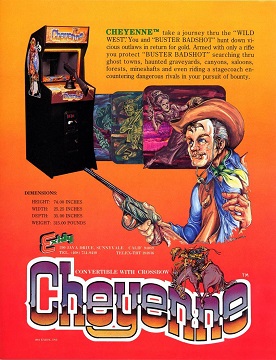
Cheyenne is a video game manufactured by Exidy and released in arcades in 1984. In this western style shooting game, the player must guide and protect "Buster Badshot" through various scenes of danger that take place in the old west, using the light gun. The gameplay is similar to Exidy's Crossbow.

Circus is a block breaker arcade video game released by Exidy in 1977, and distributed by Taito in Japan. The game is a re-themed variant of Atari, Inc.'s Breakout, where the player controls a seesaw and clown in order to pop all the balloons in the level. The game has been copied and released under different names by numerous other companies in both the United States and Japan.

Freedom Force is a video game developed and published by Sunsoft for the Nintendo Entertainment System in 1988. The player takes the role of a sharpshooter in a counter-terrorist organization. This is one of the few games to require the NES Zapper light gun accessory. The game was released in arcades on the Nintendo VS. System as VS. Freedom Force that year.
American Game Cartridges (AGC) was an American video game developer and publisher established as a subsidiary of ShareData in 1990. Like ShareData, American Game Cartridges was headquartered in Chandler, Arizona. AGC published three video games for the Nintendo Entertainment System (NES) in 1990.



















